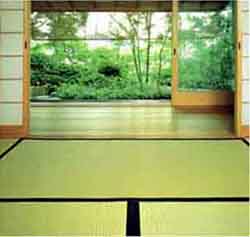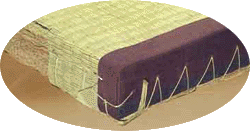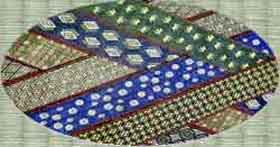| **History of tatami and relation to Japanese Room washitsu.** | |
 It is impossible to speak of Japanese culture without mentioning the existence of 'tatami' (thick mat made of rush), which provides comfort, diversity, spiritual richness for Japanese-style room, 'washitsu' - some call otherwise; 'zashiki', 'nihon-ma'('ma' means 'room' or 'compartment' in Japanese) - a room used for various purpose; living, dining, sleeping and so on. Tatami as well as washitsu is one of the sources of Japanese traditional culture. The manner of acting and etiquette in a room covered with tatami have deep liaison with our own morality and ethic.
It is impossible to speak of Japanese culture without mentioning the existence of 'tatami' (thick mat made of rush), which provides comfort, diversity, spiritual richness for Japanese-style room, 'washitsu' - some call otherwise; 'zashiki', 'nihon-ma'('ma' means 'room' or 'compartment' in Japanese) - a room used for various purpose; living, dining, sleeping and so on. Tatami as well as washitsu is one of the sources of Japanese traditional culture. The manner of acting and etiquette in a room covered with tatami have deep liaison with our own morality and ethic.Nowadays, we see some occidental people enjoying their lives on tatami. They usually lay one or two tatami mats on wooden or plaster floor and make seats, bed and so on. That is how Japanese tatami culture began. It is said that Japanese noblemen started using tatami on wooden floor as cushion or mattress more than one thousand years ago. Tatami-covered room is supposed to appear about six hundreds years ago during the Muromachi-era.This room style became popular among samurai, city craftworkers and merchants during the Edo era. |
|
| **Function of tatami and Washitsu.** | |
|
Washitsu is space that could be what users would like it to be. Tatami-covered washitsu is sometimes formal space with tension; meeting room with highly ranked priest in Buddhist temples, tea ceremony room, 'zashiki' room with 'tokonoma'; narrow hollow space, suggesting where in the room an upper seat is, in which we display picture, calligraphy and ikibana mostly to watch and enjoy. For everyday life, washitsu does offer open space for many neighbors or families to gather and to make themselves 'at home.' With a zataku table (low but large table to be seated without chair but cushion on tatami), this is a guest room. With futon only, you are in a sleeping room. Of course children and adolescents know well how to transform the same room into studying room; reading, writing, tea-ceremony rehearsal, ikebana. As washitsu is usually divided into two or a few by 'shoji' - light sliding door mainly made of wood and paper, several small washitsu could, be united into a large hall by removing them. One more attraction. when opening shoji facing to the yard, our living space gets wider and opener to the green-rich, water-fragrant air. It is a good example of our philosophy; living with nature. Tatami, made of natural products, is very good for human body in many ways. Its fragrance can, like one in the forest, tranquilize human nerve strain. It also conditions air. Paddy stem used for its core regulates humidity of the washitu. By eliminating nitrogen dioxide supposed to cause air-poisoning, its surface cleans up the air. Furthermore, it makes the room comfortable in each season, providing cool refreshing touch in summer and slight warmth by blocking cold wind coming up under the wooden floor in mid-winter. Besides, one of the best elements of tatami is physical adequate elasticity. It supports human body and relieves us of too much gravity and pressure. |
|
| **How to make tatami.** | |
 Tatami is a Japanese-born flooring material functional for humid and temperamental climate. The size of a sheet of tatami is around 180 cm long and 90 cm wide, which is alternative depending on the region. In a room with eight tatami in largest scale, you can install another chest or closet than in smallest one. Each tatami consists of 'tatami-omote'(upside-surface),'tatami-doko'(core and downside to put on the wooden floor) and 'tatami-beri'(fringe). First, craftsperson sew straw and make it thick and strong enough to be tatami-doko. Then they cover it with tatami-omote woven with rush and hem with tatami-beri cloth.
Tatami is a Japanese-born flooring material functional for humid and temperamental climate. The size of a sheet of tatami is around 180 cm long and 90 cm wide, which is alternative depending on the region. In a room with eight tatami in largest scale, you can install another chest or closet than in smallest one. Each tatami consists of 'tatami-omote'(upside-surface),'tatami-doko'(core and downside to put on the wooden floor) and 'tatami-beri'(fringe). First, craftsperson sew straw and make it thick and strong enough to be tatami-doko. Then they cover it with tatami-omote woven with rush and hem with tatami-beri cloth.
|
|
| Tatami material 1:"Tatami-doko" |
| Tatami-doko is the core of tatami-mat, which is important to exhibit the practical feature and function of tatami as well as supporter of its apparent beauty and comfort. It is usually made of straw bed. Paddy stem is the most popular material. |
| Tatami material 2:"Tatami-omote" |
| The atmosphere of washitsu depends on the quality of tatami-omote. Rush, perennial growing in damp, is used for it. Planted in mid-winter and cropped under the burning sun in summer, dried, they choose stems with enough thickness, length with good color for tatami-omote. Around 4.000 to 5.000 stems of rush are necessary to weave a sheet of tatami-omote. Today rush for tatami-omote is planted in fifteen regions in Japan. Every rush has its own color, splendor and strength. So it is used according to purpose. |
| Tatami material 3:"Tatami-beri" | |
 Tatami-beri (fringe) is very important both for decoration and maintaining durability. It sets simple beauty of tatami-omote off and gives formal tension to washitu. Tatami-beri is ordinarily order-made because it should be decorated, by the social ranking of the family to live in, with family color and 'kamon' (family crest) like hishi-mon, kikkou-mon, kikka-mon. Nowadays, new designs and color have been developed for tatami-beri according to change of our modern life style, so there are more than two thousands of design, which we can choose by our own taste. The material in highest quality is linen, though polyester is mainly used for mass production.
Tatami-beri (fringe) is very important both for decoration and maintaining durability. It sets simple beauty of tatami-omote off and gives formal tension to washitu. Tatami-beri is ordinarily order-made because it should be decorated, by the social ranking of the family to live in, with family color and 'kamon' (family crest) like hishi-mon, kikkou-mon, kikka-mon. Nowadays, new designs and color have been developed for tatami-beri according to change of our modern life style, so there are more than two thousands of design, which we can choose by our own taste. The material in highest quality is linen, though polyester is mainly used for mass production.
|
|
| **Conclusion.** | |
| Now you know better about our culture based on tatami. As mentioned above, this fine and delicate furniture is fabricated by weaving and tying up material in nature. Here you can see for Japanese culture 'tying' is one of the most important philosophy, which our 'mizuhiki' craft also stands for. | |